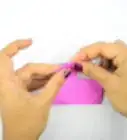wikiHow is a “wiki,” similar to Wikipedia, which means that many of our articles are co-written by multiple authors. To create this article, 24 people, some anonymous, worked to edit and improve it over time.
The wikiHow Video Team also followed the article's instructions and verified that they work.
This article has been viewed 418,731 times.
Learn more...
Asian designs are resurgent in popularity, especially in interior design. Tissue paper Japanese lanterns add a Zen feeling to your home with the clean look of rice paper and the soft glow of muted light. Japanese lanterns made of construction paper are great for outdoor deck parties, and can liven up the mood. No matter what lantern you choose to make, they are both relatively easy and fun to create.
Steps
Creating a Tissue Paper Japanese Lantern
-
1Gather your materials. The most important thing to buy is bendable metal wire. This can usually be found at arts and crafts stores, as well as hardware stores. Instead of forming your own metal structure, you can also buy pre-made metal wire structures which can save you time. You will also need to buy:[1]
- Tissue paper (different colors)
- Super glue or hot glue
- Scissors
- Hole-punch
- String
- Wire cutters
- Acrylic or watercolor paint (optional)
-
2Find a mold for your lantern. Unless you are exceptionally skilled at making wire forms, you’ll need a guide. If you want a rounded lantern, find an appropriately sized ball, bowl, vase, tin can, etc. to wrap the wire around. If you want a polygonal lantern, either find a suitable object to wrap the wire around or make a unique mold out of scrap materials.[2]Advertisement
-
3Wrap the wire around the mold. Start by wrapping the wire once around the bottom end of your form. Continue wrapping around your frame in a spiral until you get to the top. Since the amount of wire you need will depend on the size of the lantern and tightness of the spirals, it may be a good idea to use wire directly off the spool instead of cutting it in advance.[3]
- Leave an opening at both the top and bottom of your wire frame. A totally enclosed lantern will trap heat and become a fire hazard.
- Try to keep your wire wraps about 1/2 inch apart from one another.
- Be sure to leave a length of free wire at either end of your mold.
-
4Remove the wire frame from the mold. Be prepared to resize and reshape the frame when you’re done, as it may spring open slightly after removal. Depending on the shape, you may need to pull your wire frame completely open in order to retrieve the mold. Do this gently so that you can reshape it easily when you’re done.[4]
-
5Secure each opening of your frame with wire. Where the top- and bottom-most spirals end (and become extra wire), attach the extra wire to the nearest spiral in the frame to preserve the shape of the opening. You can do this by either wrapping the wire or with a soldering iron.[5]
- This should only use a bit of your extra wire. Make sure you have some left for additional structuring.
- For more information on soldering, visit: How to Solder Wire Sculptures
-
6Form a base for your lantern. Be sure to choose the opening that will have the lamp cord (if hanging) or lamp base (if upright) sticking through it. Your exact design will depend on the structure of the lamp you put the lantern on.[6]
- If you plan to hang your lantern, run the extra wire at the top of the frame straight across the top opening, looping it once in the middle before wrapping or soldering it to the other side. When the lantern is ready to hang, you will run the lamp cord through this loop, tying a knot underneath to hold the lantern in place.
- If your lantern will sit atop a lamp, run the extra wire at the bottom of the frame straight across the bottom opening, looping it once in the middle before wrapping or soldering it to the other side. Be sure the loop is large enough to accommodate the structure that will poke up through the bottom of the lantern.
- Depending on the lamp, you may also need to do make structural adjustments to the opposite opening of the lantern.
-
7Cut paper panels. With a polygonal frame, this will be relatively simple because your paper will be roughly rectangular. With a round frame, you'll have to experiment with small strips or almond-shaped panels of paper. When it comes to round frames, the smaller the pieces of paper, the smoother the final look will be. As you cut each piece, lay them gently against your wire structure to see how the paper fits against it.[7]
- Decide how many panels you need. For a square or rectangular frame, you can either create a separate panel for each side or wrap the entire sides with one sheet.
- Cut the panels a little larger than they need to be so they can overlap. Don't worry if you make a mistake and miss a spot. You can always come back and cut a new piece of paper to cover the empty spot.
-
8Glue the first panel to the wire frame. It is best to use either hot glue or super glue, as regular school/table glue will not hold the paper to the wire. Wrap the top edge of the paper around the top opening in the wire frame and glue the paper where it overlaps itself. Stretch the paper taut, pulling it down over the wire spirals to the bottom of the frame, where you will again wrap it around the opening and glue it.[8]
- Once you are done, let the structure have a few minutes to dry completely.
-
9Glue the remaining panels. From here on, you will be able to glue at least one edge of each panel to the neighboring panel. Remember to wait until each panel is dry before adding another. If you realize you do not have enough paper strips to cover the entire structure, go back and cut some more. There should be no remaining space between strips when you are done.[9]
-
10Decorate your lantern (optional). Lanterns often have characters or designs painted onto the sides. You may also want to paint your paper a solid color, or perhaps stripes. You may even want to add a traditional Japanese design, such as flowers, nature, or native Japanese animals.[10]
- For more information on how to watercolor paint, visit: How to Paint With Watercolors.
- For more information on how to paint with acrylics, visit: How to Acrylic Paint.
-
11Finish off your lantern. This step is only for those hanging their lanterns. Use a hole-punch to punch a hole into the paper of your lantern. You will want two holes at the top of your structure, one directly across from the other. Cut a piece of string that is at least 12 inches long (length will vary depending on how and where you will hang the lantern). Feed the string from the outside in, into each hole. Tie a knot on each end of the string to hold the lantern as it hangs.[11]
Making a Traditional Japanese Paper Fan
-
1Obtain your materials. First, you will need a plain piece of 12X18 inch construction paper. You can also use printer paper, or card stock, depending on the materials you have available. The color of the piece of paper is up to you, however, remember that the darker the tone or color, the harder it will be to see the design. You will also need:[12] [13]
- A pair of scissors
- A ruler
- A stapler
- Tissue paper (color of your choice)
- Watercolor or acrylic paint
- Small paintbrush
- Glue
- Hole-punch
- String
-
2Paint on your design. Lay your piece of construction paper on a flat surface that is safe to paint on. You may want to lay some old newspapers down first so that you do not damage your painting surface. If you are using acrylic paint, apply a small amount of paint to a clean paper plate. Dip your paintbrush into the paint, and apply it to the construction paper in small brushstrokes.[14]
- If you are using watercolor paints, add a tiny bit of paint to a paper plate. Then, fill a jar of cool water and keep it next to the paper plate as you paint. Add a small amount of water to the paint on the paper plate. Dip your brush into the paint and dab it onto the construction paper in small brushstrokes. Continuously add water when the paint starts to dry up.
- For more information on how to use acrylic paint, visit How to Acrylic Paint. For more information on watercolor painting, visit How to Paint With Watercolors.
- While you can paint any design you wish, traditional Japanese designs usually include flowers, nature, and animals native to the country of Japan. If you wish to go the more traditional Japanese route, you can visit https://learnodo-newtonic.com/famous-japanese-artists-and-paintings as a general guide.
- After you have painted your design, give your piece of paper at least a day to fully dry.
-
3Cut your piece of paper. First, you will need to fold your paper in half length wise (join the short ends of the paper together). Make a solid crease, either with your hand, or a semi-heavy object like a paperweight. Take your ruler, and mark a 1/2 inch down from where the two short edges meet. Draw a straight line across the piece of paper at this 1/2 inch mark.[15] [16]
- Next, take your ruler to the folded edge. Make a small pencil mark every 1/2 inch (should be 23 marks in total for a piece of paper 12 inches wide). Then take your ruler, and line up each of these marks, with the 1/2 inch line you previously drew. Connect each of these marks to that 1/2 inch line.
- Take your pair of scissors and cut along each of these lines. However, do not cut the 1/2 inch line you drew near where the short edges meet.
-
4Bend and twist your piece of paper. After you have finished cutting, open your folded paper up. Take the two long ends of the paper and bring them together with your hands (overlapped by about 1/2 inch). At the same time, compress/bend your paper slightly so that the strips of paper you just cut begin to pop out and bend.[17] [18]
- After the paper is compressed slightly, and you have joined together the two long ends, hold the lantern in position.
- Staple the long edges together. It might be best for you to hold the lantern in the proper position as another friend or relative staples the ends together.
- After you have the ends stapled together, you can then go back over the joined edges with clear tape. This will keep your lantern from falling apart.
-
5Cut out strips of paper. Each of the strips should be a different color than the rest of your lantern (the strips themselves can be the same color as each other). Use a ruler to measure out two rectangles that are 1/2 inch X 12 inches. Cut each of these strips of paper out with a pair of scissors.[19]
- Apply some glue (super glue or regular glue) to the backside of one of the strips. Wrap the strip around the top of the lantern, where you did not previously cut into. Hold the strip there for five minutes, or until the glue is dry.
- Repeat the previous step, except this time, wrap the second strip on the bottom of the lantern.
-
6Finish off your lantern. Use a hole-punch to punch two holes through the top part of your lantern, one directly across from the other. Next, cut a piece of string at least 12 inches long (length will vary depending on how and where you will hang the lantern). Feed each end of the string through the top, inside of the lantern, each end going through one of the holes. Pull the string through each hole and tie a knot on each end. Your lantern is now ready to hang.[20] [21]
Community Q&A
-
QuestionDoes this lantern function?
 Community AnswerIf you make it the right way, it will work. Add a heatless light or fake candle so it lights up.
Community AnswerIf you make it the right way, it will work. Add a heatless light or fake candle so it lights up. -
QuestionIs there any other way to make these lanterns?
 Kim GTop AnswererYou can make them out of construction paper, or other materials. You can find a number of different versions of the instructions online.
Kim GTop AnswererYou can make them out of construction paper, or other materials. You can find a number of different versions of the instructions online.
Warnings
- If you decide to solder your wire together, make sure to use the proper protective gear such as gloves, goggles, and an apron.⧼thumbs_response⧽
- Don't draw on with Copic markers. This may result in fire.⧼thumbs_response⧽
- Don't drop lantern in water.⧼thumbs_response⧽
- You can also use a tea light candle to light your lantern, but make sure it is mounted securely. The flame should not come near the paper. Remember that the flame does not need to come into contact with a surface to light it on fire. Use caution if you use a candle and be sure to keep an eye on it. Never use this kind of lantern if there is wind.⧼thumbs_response⧽
References
- ↑ http://www.justartifacts.net/palaasinfrma.html
- ↑ http://www.justartifacts.net/palaasinfrma.html
- ↑ http://www.justartifacts.net/palaasinfrma.html
- ↑ http://www.justartifacts.net/palaasinfrma.html
- ↑ http://www.justartifacts.net/palaasinfrma.html
- ↑ http://www.justartifacts.net/palaasinfrma.html
- ↑ http://www.justartifacts.net/palaasinfrma.html
- ↑ http://www.justartifacts.net/palaasinfrma.html
- ↑ http://www.justartifacts.net/palaasinfrma.html
- ↑ http://www.justartifacts.net/palaasinfrma.html
- ↑ http://www.justartifacts.net/palaasinfrma.html
- ↑ http://thecraftyclassroom.com/crafts/japan-crafts-for-kids/japan-lantern-craft-for-kids/
- ↑ http://innerchildfun.com/2013/07/how-to-make-easy-paper-lanterns-japan.html
- ↑ http://thecraftyclassroom.com/crafts/japan-crafts-for-kids/japan-lantern-craft-for-kids/
- ↑ http://thecraftyclassroom.com/crafts/japan-crafts-for-kids/japan-lantern-craft-for-kids/
- ↑ http://innerchildfun.com/2013/07/how-to-make-easy-paper-lanterns-japan.html
- ↑ http://thecraftyclassroom.com/crafts/japan-crafts-for-kids/japan-lantern-craft-for-kids/
- ↑ http://innerchildfun.com/2013/07/how-to-make-easy-paper-lanterns-japan.html
- ↑ http://thecraftyclassroom.com/crafts/japan-crafts-for-kids/japan-lantern-craft-for-kids/
- ↑ http://thecraftyclassroom.com/crafts/japan-crafts-for-kids/japan-lantern-craft-for-kids/
- ↑ http://innerchildfun.com/2013/07/how-to-make-easy-paper-lanterns-japan.html




















































